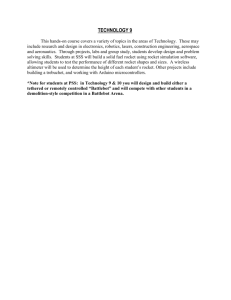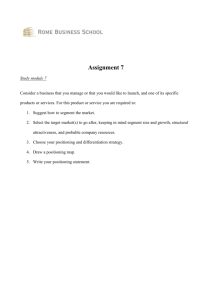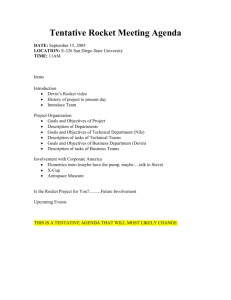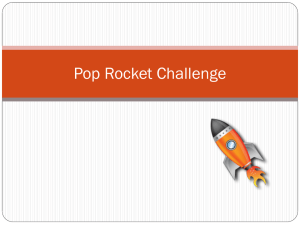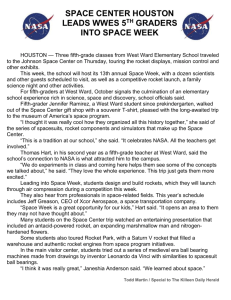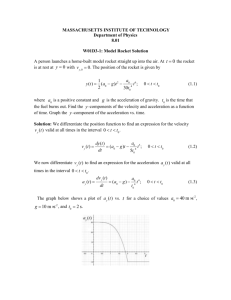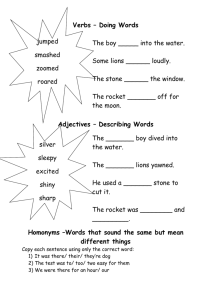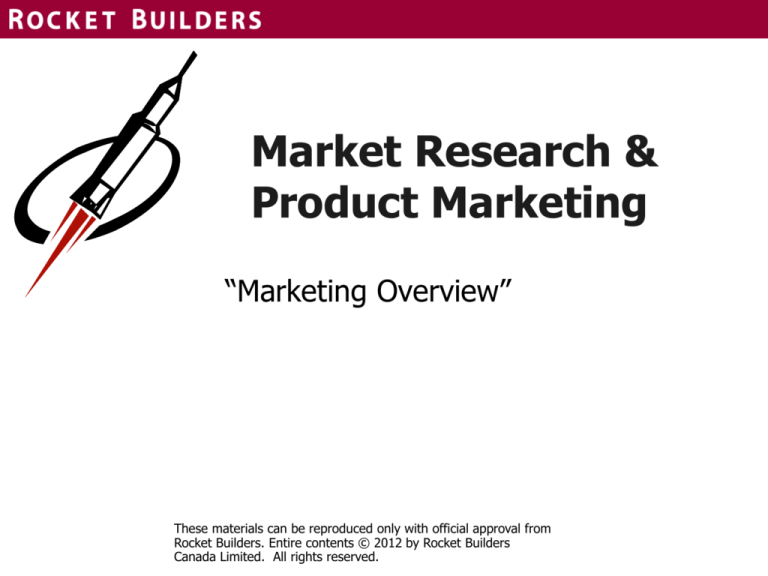
Market Research &
Product Marketing
“Marketing Overview”
These materials can be reproduced only with official approval from
Rocket Builders. Entire contents © 2012 by Rocket Builders
Canada Limited. All rights reserved.
2
Dave Thomas 604-603-8630
dthomas@rocketbuilders.com
www.rocketbuilders.com
Ready to Rocket and Emerging Rockets
Past NVBC award winners
http://www.readytorocket.com/
Canadian Financing Forum – Venture Capital Event
February 2014 www.financingforum.com
3
Sailing school at Jericho Beach
www.macsailing.com dave@macsailing.com
Shenzhen Sun Sailing, Shenzhen China
http://www.sunsailing.net/page/Default.asp?pageID=16
Marketing Research
Technology Adoption Models
Understanding Consumers
‘Whole’ Solution Offerings
Product Positioning
Pricing
Metrics
Answer Questions: 1, 5, 6, 7, 8, 9
These materials can be reproduced only with official approval from
Rocket Builders. Entire contents © 2012 by Rocket Builders
Canada Limited. All rights reserved.
5
Learning Objectives for Today
Taking the time for market research increases your
chances for success.
Understand the concepts of technology adoption
cycles and whole product and how it impacts market
entry.
Understand how product positioning influences all
messages in marketing materials.
Understand how pricing is determined and what
models can be employed.
Understand how to measure marketing effectiveness analytics
Successful Growth Companies
1. Minimum Viable Product
evolves to become……
2. … the product demanded
by the market including a
viable revenue model
3. Addressable market with
an ‘engine of growth’ or a
clearly defined niche
market
Product
Market
Revenue
Market Research
These materials can be reproduced only with official approval from
Rocket Builders. Entire contents © 2012 by Rocket Builders
Canada Limited. All rights reserved.
8
Begin With The End In Mind
Start here…
Key
Market
Research
Questions
Up to
Market
Research
Report
(Outline)
What will the
answers to these
questions tell you?
3X
Market
Research
Plan &
Budget
What resources & time are required
to answer these questions?
Value Proposition
“Whenever you get confused… go to the store… the
customer has all the answers… and all the money.”
—Sam Walton
Founder Wal-Mart
Value of Your
Offering
Value Offered
by Competitors
9
10
Markets, Pains & Requirements
Markets
Size
Trends
Segments
Pains
Customer Pain
Value Chain Pain
Requirements
Customer Requirements
Channel Requirements
11
Market Segmentation
Revolutionary Products
Segment originates with technology or product
Vendors can’t predict next innovation or its
consequences
Evolutionary Products:
Segment is pre-defined; challenge is to refine
definition/redefine
Mainstream market customers insist vendors fit
solution to their problem
12
Why Segment?
Focuses scarce marketing & development
resources on target customer group
Narrows whole product definition
Limits real competitors
Leverages past success into other segments
Allows the benefits of market leadership to
develop more quickly
Why? - Marc Andreessen
What’s most dangerous, a bad team, a weak product or a poor
market?
The # 1 company killer is lack of
market
Getting to product/market fit really
matters
Why? - Steve Blank
Blank - Hypotheses versus Reality
Large companies execute in a market
Start-ups ‘search’ for a business model
Build, Measure, Learn
Ship it and see what happens
or
Make a prediction, ship, measure the results,
repeat and then see what happens again
Prove that your product fits the market - Reality
Top Down Versus Bottom-up
Revenue is NOT a function of market share, size,
and penetration rates
($ 1B market x 2% penetration = $20 M)
Revenue IS a function of the leads you attract,
conversion rates, price and individual customers
Lx%xP=R
Top Down is Valuable
Total addressable market (TAM) is a term that is
typically used to reference the revenue opportunity
available for a product or service.
•
•
•
•
•
•
Theoretical Market
Potential Market
Available Market
Addressable Market
Target Market
Market Demand
Bottom-up – The Market
Target markets are groups of individuals
separated by distinguishable and noticeable
aspects.
• Available Budgets
• Market Reach
• Attach Rate
• Conversion Rate
• Win Rate
Basic Forecasting Approaches
Top Down:
Develops a forecast of
economic conditions and
industry trends.
Determines the market
potential for a product.
Determines the sales
potential for the product.
Measures the share of
this market the firm is
currently getting or plans
to capture.
Forecasts the firm’s sales
of the product.
Bottom Up:
Generates estimates of
future demand from
customers or the
company’s salespeople.
Combines the estimates
to get a total forecast.
Adjusts the forecast
based on managerial
insights into the industry,
competition, and general
economic trends.
Internet - Addressable Market
Try starting with your current audience. That is, the
sum total of all the subscribers, website visitors,
friends, associates, readers, followers and contacts.
These are all people immediately within your reach.
•
•
•
•
•
•
Website Visitors
Blog Readers
Twitter Followers
User Group participants
Facebook Followers
Through Advertising
Headpin Segment
Highly accessible & high demand
Success/leadership in this target segment
provides as a basis for further market
expansion into related marketplaces.
21
22
Bowling Alley Model
”Target a single niche market segment
with a ‘must-have’ value proposition”
(In Bowling Alley)
• Identify a segment you can dominate
• Win market share leadership in that segment
• Leverage leadership to win over adjacent segments
New Ventures BC – Evaluation
1. Are you sure that the market opportunity is
attractive and worthwhile?
2. Do you know how and why will you win in
the marketplace?
or
Is it unclear about the product, competition and
why customers can’t live without it?
Understanding the Market
Internal Focus
External Focus
Product & Feature
Customer Value
Lots of Features
Differentiation
Reactive R&D
Headpin Segment
Unpredictable Results
Reliable Customers
25
SECONDARY
RESEARCH
PRIMARY RESEARCH
Internet, books, articles
Face to face, surveys
Free or easily purchased
e.g. StatsCan/Census
Cost investment
(time or money)
Fast
Less fast
Broad strokes
Targeted
Available to all
For your eyes only
26
PRIMARY RESEARCH
QUALITATIVE
QUANTITATIVE
A few people
Lots of people
In-person or telephone
interview
Surveys
In-depth
Stats
Directional
Decisions
Answers the Why
Answers the other Ws
27
Do
Listen to customers
Understand the whys
Keep it short
Negatives and positives
Stay neutral
Don’t
Sell
Just ask your friends
Shy away from the
hard questions
Ask questions with 1
word answers
Get emotional
28
Key Market Research Questions
What is your target market?
How big is it?
Who buys your product?
Why do they need it?
Who pays for it?
Who uses it?
How does the customer fix the business problem you
are addressing today?
How much are they willing to pay?
Why would they buy from you?
What business problems are more important to them than this
one?
“BusinessWeek October 20, 2004. “Taking the Trouble to Research Your Market.”
http://www.businessweek.com/smallbiz/content/oct2004/sb20041020_9945.htm
29
Market segmentation
Total
Market
Addressable
Market
Market
Segments
Market
Share
$20M
Market 1:
$10 M
$100M
$ 00B
Market N:
$00 B
Market 1
$80M
$60M
$10M
$10M
Market 2
$40M
Low margin business
20% market share
$ 30 M
Here is where an organization develops a unique, competitive
view of the market and identifies specific opportunities to pursue
which will provide significant, sustainable growth! Within overall
markets, identifying markets that an organization can realistically
address is a critical challenge.
From here, market opportunities can be broken down further to
uncover the segments that offer the best growth and margin.
This will lead an organization to revenue opportunities which are
grounded in market realities and therefore more attainable over
the short to long term.
Technology Adoption Cycle
‘The Chasm’ - How it develops and
What to do About it
These materials can be reproduced only with official approval from
Rocket Builders. Entire contents © 2012 by Rocket Builders
Canada Limited. All rights reserved.
31
Technology Adoption Cycle
Provides an understanding of customer
requirements e.g. Why buy? What’s
in it for me/us?
Establishes focus for and timing of
marketing strategy. How and when to
execute marketing activities.
32
In-Stat: Early Adopters (consumer)
In-Stat’s research (2010) identifies that early adopters
are much more likely to:
Subscribe to premium pay-TV channels
Two-thirds get at least one premium channel
Over 50% receive HBO
Subscribe to a DVR service
View VoD content
View fee-based on-demand movies
Purchase pay-per-view content
Subscribe to fee-based sports content (e.g. NFL
Sunday Ticket)
Spend more than 5 hrs per day viewing video content
33
In-Stat: Early Adopters (consumer)
Recent research (2009) by In-Stat found the following:
By 2013, nearly half of total US households will have an adult
that considers themselves to be a leading-edge or early adopter
of technology.
In-Stat recently developed new end-user segmentation that
identifies “Power”, “Social”, and “Passive” Internet Users.
Segmentation is based on the number of different Internet
activities and the frequency that they are performed.
Over the next five years, Internet power-user households will
double in number, and nearly two-thirds of US broadband
households will be power or social users.
34
Buyer Internet Behaviour
35
Buyer’s Process
Source:
www.sellxl.com
Content Copyright 2013, Rocket Builders
36
Determining Buyer’s Process
What are the stages a buyer goes through as they
decide whether to engage with your company?
Pretend you’re the buyer.
When do you recognize that you need help with a particular
problem? [This is the first step in the buyer’s process.]
What will you do to find potential solutions? List all of the
steps you’ll take as you research solutions, find potential
vendors/providers, start discussions, narrow your choices,
etc., all the way until you negotiate/execute a contract and
become a customer.
Content Copyright 2013, Rocket Builders
37
Role of Search in Buyer’s Process
Content Copyright 2013, Rocket Builders
38
How many people are involved?
2007 “Business Technology Buyers
Survey”
Size of Buying
Organization
100 to 500 employees
501 to 1000 employees
Over 1000 employees
Participants in
Buying Process
6.8
13.5
21.0
Content Copyright 2013, Rocket Builders
39
Participants in Buying Process
Users
are members of the organizations who will use the product or services. In many cases,
users initiate the buying proposal and help define the product specifications.
Influencers
often help define specifications and also provide information for evaluating
alternatives. Technical personnel are particularly important influencers.
Buyers
have formal authority to select the supplier and arrange terms of purchase. Buyers
may help shape product specifications, but their major role is in selecting vendors and
negotiating.
Deciders
have formal or informal power to select or approve the final suppliers. In routine
buying, the buyers are often the deciders, or at least the approvers.
Gatekeepers
control the flow of information to others. For example, purchasing agents, often have
authority to prevent salespersons from seeing users or deciders.
Content Copyright 2013, Rocket Builders
Social Media
These materials can be reproduced only with official approval from
Rocket Builders. Entire contents © 2012 by Rocket Builders
Canada Limited. All rights reserved.
41
Social Media Platform Tools
42
B2B Social Media Marketing
93% of all B2B marketers are
engaged in some form of social media
marketing
with most putting their focus on the most
popular channels
LinkedIn
Facebook
Twitter.
Source: BtoB Magazine
Content Copyright 2013, Rocket Builders
43
Social Media Stats
Facebook
750 million users, up from 500 last year
30 billion pieces of content shared per month
LinkedIn
over 120 million user accounts,
Twitter
over 100 million active users
one billion Tweets published every day
Blogs
over 156 million public blogs in existence
Videos
2 Billion videos viewed per day on YouTube
Content Copyright 2013, Rocket Builders
44
Top Tools in the B2B Toolkit
Publishing
Networking
Social Platforms
Sharing
Discussion
Content Copyright 2013, Rocket Builders
Social Media for Competitive Intelligence
1.
2.
3.
4.
5.
6.
7.
More than brand and customer service
Real Time Information - tweets
Follow corporate accounts of competitors
Follow executives of competitors
Track product launches and news
Do trend analysis with key words & competitors
Policy what can be tweeted, when and by whom
Internet Tools – Use more than One
1.
2.
3.
4.
5.
6.
7.
8.
9.
Alexa
Google Analytics
Google DoubleClick Ad Planner
Google Insights for Search
Microsoft adCenter Labs
Google AdWords Keyword tool
Kissmetrics
Hubspot
Hootsuite
Whole Product
These materials can be reproduced only with official approval from
Rocket Builders. Entire contents © 2012 by Rocket Builders
Canada Limited. All rights reserved.
48
Whole Product Definition
Physical Product
+
All Associated Factors
(services, partners, warranties,
guarantees, image, training, etc.)
=
“The Whole Product”
Both tangible & intangible elements required by target
customer to solve his/her whole problem.
49
The Whole Product Concept
Determines which pieces company intends to
provide
Remaining areas must be filled in by partners
Provides focus on customer requirements
Time to Market Acceptance: Accelerates
mainstream market acceptance
Competitive Barriers: establishes differentiators
in a commodity/standards world.
50
The Whole Product
Consulting
Complementary
Services
Post-sales
service
& support
Pre-sales
services
Hardware
Core
Product
Software
Peripherals
Complementary
Products
Connectivity,
Legacy
SI
interfaces
All other products, services and relationships needed by the
target customer to fulfill their compelling reason to buy
Source: Crossing the Chasm, Geoffrey Moore
51
Coffee Example
52
Whole Product Questions
What complementary services must be
acquired with your product?
What additional hardware or software must
be purchased to deploy your product?
Will customers achieve ROI without
complementary products or services? How
will these ‘total cost of ownership’ issues
affect:
Your sales process?
Customer satisfaction?
53
How Do you Market the Whole Product?
Evidence of whole product solution
Launch activities
Partnerships, alliances
Sales people (solution sell capability
Manage the evidence of whole product
solution
Contact points with customer? What are their
issues
Build reference base
Develop infrastructure marketing programs
Positioning
These materials can be reproduced only with official approval from
Rocket Builders. Entire contents © 2012 by Rocket Builders
Canada Limited. All rights reserved.
55
Definition
Why will they buy from us vs. our
competition?
Positioning = Managing the product
and its presentation to fit a
predetermined place in the mind of the
customer
Positioning = Market + Competitive
Segmentation Differentiation
56
More Definitions…..
Perceived status within market
segment. (Exists in people’s heads)
Build relationships to secure &
communicate competitive advantage.
(Something marketing folks do)
57
Positioning Impact
Partnerships
Competition
Company
Valuation
Pricing
Product Position
Whole
Product
Distribution
Service/Support
Sales Cycle
58
Positioning Process
Market
Research
Market
Segmentation
•Demographics
Competitive
Differentiation
•Psychographics
•Channels
Understand
Choose
Differentiate
Marketing Plan
Test
Positioning
Statement
Put stake in the
ground
•Target Accounts
•Product
Launches
Reinforce in
market
59
Product Positioning – How You Describe Your Product
To Potential Customers
1. Customer: Who do we / could we sell to?
2. Need: What problem is our customer trying to
solve, or opportunity to address?
3. Products: What do we / could we sell to meet our
customer’s need?
4. Differentiation: Who else can address our
customers’ needs. How are we different?
5. Whole Product: What else is needed to get a
solution to the problem?
6. Positioning Statement Development.
60
The Positioning Statement
Positioning Criteria:
Who is the target
customer? Is this the
decision maker?
What is the compelling
reason to buy?
What is the product
category?
What is the key benefit of
that product category?
Who is the main
competitor?
What is the key
differentiation of this
product?
Positioning Statement:
For (target customer)
Who (compelling reason
to buy)
Our product is a (product
category)
That (key benefit)
Unlike (main competitor)
Our product (key
differentiation)
61
Positioning Example: Apple iPod
For mobile, high-income individuals
who need a way to listen to their entire music
collection in different settings
the Apple iPod is a small, portable digital music
player
that offers elegance of design, the ability to store
an entire music collection, and easy purchasing
of new digital music.
Unlike flash mp3 players (Creative, Rio, etc),
the product stores an entire music library and is
integrated into a service to purchase new
digital music (iTunes)
EXAMPLE FROM 1985 - Starbucks
For: Sophisticated coffee drinkers
Who: value excellent coffee and an
amazing customer experience
The: Starbucks experience is a unique
retail chain
That: adds to the quality of coffeedrinkers’ lives.
Unlike: Drip coffee served in a plastic
cup
At Starbucks: we’re making coffee a
new way and providing a unique
environment for drinking it
Market Category?
Brand Promise?
Tagline?
Differentiation?
63
Positioning?
64
Competitive Examples
Apple Macintosh versus Windows/PC
Content Copyright 2010, Rocket Builders - for Use Only by Market Readiness
Program Participants
65
Product Positioning Exercise
(12-18 months out)
FOR [target customer segment]
Who wants/needs [solution to problem]
The [product name] is a [product category]
That provides [compelling reason to buy from vendor]
Unlike [main competitor]
The [product name [key differentiator]
66
Elements of a “Great” Positioning
Company
Fit with company
strategy
Fit with company
capabilities
Fit with corporate
culture
Fit with product
strategy
Fit with physical
product
Fit with brand
Customer
Credible
Relevant
Unique
Durable
Emotionally
appealing
Context
Fit with trends
Unique vs.
Competition
67
Acid Test for Product Positioning
(ask yourself the following)
Can competitor’s product name be
substituted?
Is there a relationship between
compelling reason to buy and key
differentiator?
Pricing
These materials can be reproduced only with official approval from
Rocket Builders. Entire contents © 2012 by Rocket Builders
Canada Limited. All rights reserved.
69
Common Pricing Issues
What are some common price objections you
hear? Is your price too high or too low?
How does you pricing model compare with
the industry? With your competition?
Do you offer promotional pricing? How
effective is it?
What licensing alternatives do you offer?
What discounts do you provide to resellers?
70
Price Constraints
Price Ceiling
Channel
Competitive Pressures
Customer Buying Restrictions
Value Proposition
Reputation of Seller
Total Cost of Ownership
71
Pricing Factors
Internal Factors
Objectives of the Firm
Marketing Mix strategy
Costs
External Factors
Nature of the market
Demand
Competition
Channel pressures
Pricing Decisions
72
Pricing Strategies
Cost-plus pricing - set the price at the
production cost plus a certain profit margin.
Target return pricing - set the price to
achieve a target return-on-investment.
Value-based pricing - base the price on the
effective value to the customer relative to
alternative products.
Psychological pricing - base the price on
factors such as signals of product quality,
popular price points, and what the consumer
perceives to be fair.
73
Pricing Methodology
Determine Market Size and Segments
Define Whole Product and Product
Positioning.
Determine Cost of Goods and Cost of Sales.
Estimate the Demand Curve
Choose Pricing Model
Set Pricing Objectives
Choose Pricing Strategy
Select Pricing
Metrics & Analytics
These materials can be reproduced only with official approval from
Rocket Builders. Entire contents © 2012 by Rocket Builders
Canada Limited. All rights reserved.
Customer Validation Metrics
1.
2.
3.
4.
5.
6.
Average order size
Customer lifetime value
Average time to first order
Rate of sales pipeline growth
Improvement in close rate
Revenue per salesperson or employee
Vanity Metrics
1.
2.
3.
4.
Web traffic
Unique visitors
Return rate
Subscribers/users
5. Conversion Rate
6. Churn
Example
www.phildub.com
What does he want?
Does the web traffic help him?
How to get metrics?
Get started right away
For Inbound Marketing you have several choices
(that you can mix and match)
KISS Metrics
Hootsuite
Hubspot
For engagement
Design your product so that you can collect the metrics
you need (even if you need to embed a small cloud
app)
For CAC and LTV
Design you management system to collect this data
Copyright 2013, Rocket Builders - Content for Use Only by NRC
Program Participants
Resources – Reading Material
• First customer to first market
• Users and revenue
• Targeted marketing
80
Dave Thomas 604-603-8630
dthomas@rocketbuilders.com
www.rocketbuilders.com
Ready to Rocket 25 and Emerging Rockets
Past NVBC award winners
http://www.readytorocket.com/
Canadian Financing Forum – Venture Capital Event
February 2014 www.financingforum.com

